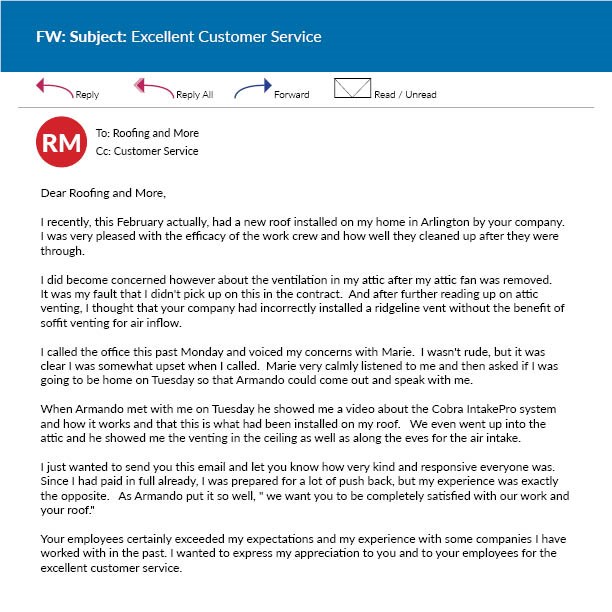Written by Lisa Frankel
Courtesy of JamesHardie

Whether you’re looking to update your home’s exterior with a new look or you need to freshen up your exterior with new siding to replace worn out or damaged cladding, completing your siding project may seem daunting. You might not know where to start, how to get financing, or what to look for, but Roofing & More is here to help answer these questions. If you approach the process step by step, siding a house becomes manageable and rewarding. This guide will cover what you need to know about the siding replacement process, but if you’d like guidance right away, give us a call today for a free evaluation of your project and estimate! No matter your siding goals, it’s possible to create your dream home.
WHERE DO I START?
The first step to siding a house is choosing the right material. Siding is your home’s first line of defense against the elements, so you’ll want to choose a long-lasting product that can stand up to weather, fire, and pests. It’s also important to choose an eye-catching design that won’t go out of style. Pick something your family will enjoy coming home to, but make sure it’ll appeal to future buyers as well. You have several options for siding your home.
Vinyl Siding
Many people appreciate the low cost of vinyl siding and the range of color options. However, it’s vulnerable to melting when exposed to heat and less resistant to bad weather than other products. Even new, it won’t replicate the appearance of real wood, and can be more susceptible to fading when compared to other products.
Wood Siding
Wood siding is a more aesthetically pleasing choice than vinyl, but its beauty comes at a higher price. It’s also susceptible to moisture, attracts pests like woodpeckers and termites, requires more frequent maintenance, and is no match for a fire.
Engineered Wood Siding
While more aesthetically pleasing than vinyl and cheaper than traditional wood siding, engineered wood is plagued by many of the same problems. It is still subject to damage caused by woodpeckers and pests, each board is natural fuel for fire, and like wood, is more susceptible to swelling, warping and cracking in response to changes in moisture.
Brick
Brick is a lower-maintenance option that is long lasting and can stand up to the elements. It helps to retain heat, which makes it useful in colder climates. But brick siding can be expensive, and it’s more limited when it comes to choosing an aesthetic, since you won’t have many color options to choose from.
Metal Siding
Metal siding is strong and durable, energy efficient, and recyclable. It resists pests and is generally easy to maintain, but dents can be difficult to repair and panels can be tricky to replace. Metal siding is also more expensive than other products.
Stone
Like brick, stone siding provides long-lasting beauty, as long as it is installed correctly. It’s sustainable and recyclable, but it’s costly. Many people choose stone veneer for a similar look at a lower cost.
Fiber Cement Siding
Fiber cement is a durable, low maintenance material made of Portland cement, sand, water, and cellulose fibers. Fiber cement siding is up to 5X thicker than vinyl and it won’t rot or sustain damage from pests, nor will it ignite in a fire. What’s more, fiber cement siding is more affordable than some of the most expensive siding options.
James Hardie invented modern fiber cement technology and homes protected with Hardie® siding have survived fires that turned neighboring homes to ash and even withstood powerful hurricanes.
Hardie® siding can remain striking for years with minimal maintenance, thanks to ColorPlus® Technology finishes. The color is baked on in a controlled environment to create a consistent finish with a stronger bond, resisting fading, chipping, peeling, and cracking. “This durability ensures that the siding will maintain its integrity and aesthetic appeal for many years, reducing maintenance and replacement costs over time,” says Jeff Akerman, licensed architect and Strategic Construction Advisor at Real Estate Bees. Lee Calisti, NCARB-certified architect, says “It’s a robust cladding that should last for many decades. It now comes in endless colors — ask to see the fan deck,” he says.
What’s more, Akerman says Hardie® siding can achieve a variety of design aesthetics, whether traditional or modern. “Hardie® siding can replicate the appearance of materials like wood or stucco, providing a multitude of design options to suit different architectural styles,” he says. Calisti agrees. “As an architect with imagination, there are few limits to what we can do with it,” he says, noting that he mixed board and batten with lap siding for his last project. “We have used Hardie® products for almost twenty years now,” Calisti says.
How to Choose Siding
Consider which siding options fit into your budget, taking into account the cost of maintenance and repairs.
Consider which siding product best fits with your design dreams. You may decide that multiple products are the best way to go, or you might choose something that offers versatility.
Consider your environment. Some siding options are better suited to certain climates than others.
Request samples. It can be helpful to feel and see each material in person.
Review warranty information so you’re aware of what is covered by each siding manufacturer.
PRICING
Once you’ve chosen a product, you’ll want to estimate the cost of your re-side project and apply for financing. Several factors influence the price of siding a house, including:
- The design and colors you choose for your project
- The size of your home
- The contractor labor required for completion
- The type of siding and siding material

You may want to meet with several contractors in your area and compare quotes. Once you know how much money you need, you can secure financing. Most homeowners choose between the following options when they take on a re-side project:
Personal Financing: If you have the cash on hand, you can avoid interest charges by financing the project yourself. If your contractor allows credit cards, you can even rack up some extra points. Just make sure to pay off the balance within the grace period.
Contractor Financing: Some contractors may allow you to pay over a period of time without incurring interest. They may also partner with lenders to offer low-interest financing, but you should compare the rates against third-party financing offers.
Third-Party Financing: You can also get a loan from a bank, credit union, or online lender. A home equity loan or HELOC would allow you to tap the equity you have in your home, but you may need to pay for an appraisal and other closing costs. A personal loan may come with a higher interest rate, but you can often avoid additional fees, especially if you have good credit.
DESIGN

Now comes the fun part. Re-siding provides an opportunity for your individual style to shine through in your home design. If you already have an idea of how you want your home’s exterior to look, you can use the Hardie ®design studio to bring your vision to life. If you still need a little help, we have some tips to clarify your vision for your dream home:
Discover Your Style: Take a style quiz to get ideas that reflect your personality and coordinate with the architectural style of your home.
Get Inspired: Download the Hardie® inspiration guide or view the home gallery to see how other homeowners have transformed their homes with Hardie® siding.
Play with Color: Consider the available siding colors in your area and narrow down your choices to colors that speak to you and pair well with your neighborhood. If the options feel overwhelming, consider the most popular color choices or explore colors curated by Joanna Gaines in the Magnolia Home | James Hardie Collection. You can also check out the Hardie® guide on how to choose exterior paint colors for your house.
Consider Accents: You may want to accent your siding by updating your gutters, windows, shutters, doors, roof, or garage. These updates allow you to incorporate bold pops of color into your overall design and achieve your desired aesthetic.
Get Hands-On: It may be easier to visualize your dream home with samples you can see and feel. Request a sample to see up to three colors in real life.
Ask Your Family: Make sure your partner is on-board with your choices. You may even ask your kids to choose their favorites out of the options you’ve selected.
Sleep On It: Check out these key steps to designing your dream home and take the time to reflect on your choices.
CONTRACTOR SELECTION

Choosing the right contractor is about more than getting the best price. You’ll want to make sure the contractor is a good fit for your project. “Pay attention to how the contractor communicates with you during the initial consultation,” says Akerman. “They should be responsive, transparent, and able to address any concerns or questions you may have.” A good contractor will:
- Meet with you, learn about your project, and understand your vision
- Measure your home to give you an accurate estimate
- Help you with your design choices and color selection
- Provide you with detailed information about product warranties
Calisti says you should also find a contractor familiar with the James Hardie installation recommendations and requirements for your climate zone. “Every product has weaknesses when not installed correctly, so working with someone who understands rainscreen building performance and addresses the cut edges, critical flashing areas, allowances for expansion, and areas requiring sealant is essential,” he says. Asking potential contractors about these issues will reveal their technical knowledge.
In addition, you’ll want to make sure your contractor is licensed and insured. You should also evaluate online reviews and testimonials for details about the contractor’s professionalism and workmanship.
Not only is Roofing & More local and familiar with our climate and all the best practices for this area we also are extremely experienced with James Hardie products and installations. During this part of your preparation for your project we encourage you to read our reviews and call us if you have any other questions. We look forward to showing you what the "More" is all about.
FINALIZE SCOPE
Once you’ve picked a design you’re excited about and chosen a contractor you can work with, it’s time to get everything in writing. Work out a timeline that works for you and your family and ask your contractor to put together a detailed schedule and payment structure. Review the contract carefully, requesting input from a trusted friend, family member, or attorney if you need it, and sign off on the project.
INSTALL
Siding projects can be messy and time-consuming. Your house may not look its best for about four to six weeks or longer, depending on the size of your house and the complexity of the project. “The number of details, colors, and textures will also impact time,” says Calisti.
But when all is said and done, your home will shine. According to Akerman, here’s what you can expect after the initial assessment:
Preparation: The contractor will remove the existing siding and address problems that may impede the project. “This may involve repairing or replacing sheathing, installing house wrap or moisture barriers, and ensuring proper insulation,” says Akerman.
Installation: Using best practices for installation, the contractor will cut and fit the siding, secure it to your home, and apply the trim.
Final Details: To ensure your siding looks polished, “the contractor will complete any necessary caulking, painting, or sealing,” says Akerman.
Clean-Up: The contractor team will clean up excess materials from the jobsite.
Walkthrough: Finally, the contractor will walk with you around the exterior of your home so you can see the finished siding project. This is your opportunity to address any remaining concerns you may have.
Once the job is complete, you can enjoy your home’s new design. If you’ve chosen Roofing & More and Hardie® siding, you’ll enjoy a low-maintenance experience with very little required to keep it looking fresh for years to come. You can view warranty information for your chosen Hardie® siding product so you can have the peace of mind that James Hardie stands behind its products and that Roofing & More stands behind their craftsmanship.
Siding replacement is a big undertaking, but if you move through the project step by step with guidance from an experienced contractor, you can enjoy a smooth process that affords you the opportunity to have fun with your design choices. Start imagining what’s possible for your home with Hardie® siding, and when you’re ready, use our contact Roofing & More to kickstart your siding project.
If you're ready to get started now, Roofing & More is running a promotion on Hardie® complete residing projects. We are currently offering 10% up to $3,000 off your project so call us today! 703.467.0206
Promotion is for a limited time only, please check availability depending on time of reading.
Subscribe to Roofing & More Inc.'s Blog






